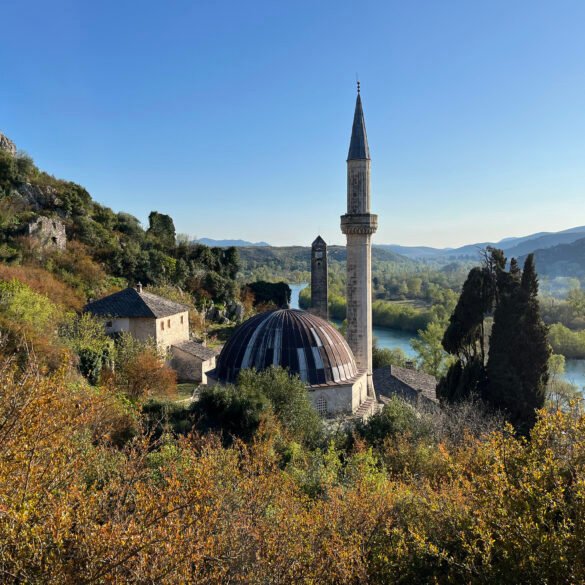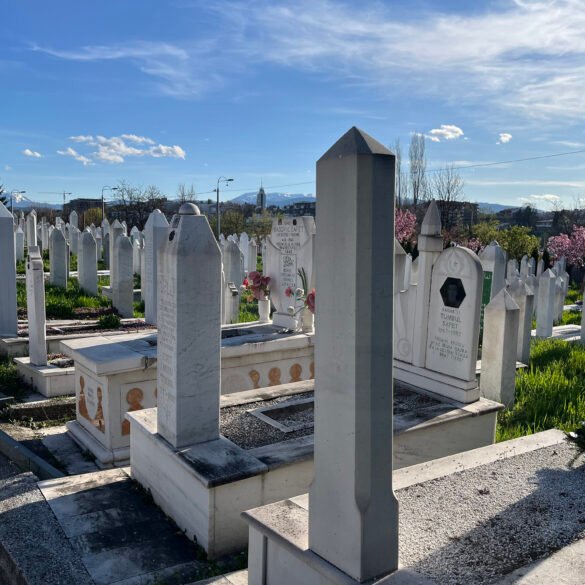Any time we mentioned we were traveling to Bosnia and Herzegovina, the first question was always the same: “Isn’t that the place with the war?”
Yes. But the war ended 30 years ago. It’s safe. Don’t worry!
That answer was usually met with a head shake and a muttered comment about us being crazy.
Our trip started like any other. We packed our bags, kissed the cats goodbye, unsuccessfully tried to sleep on the first flight to Austria, ate delicious Apfelstrudel at the Vienna airport, and then again tried to sleep on our flight to Sarajevo. Upon arrival, we rented a tiny economy car and drove an hour to Konjic, excited to start the trip and looking forward to our first cup of strong Bosnian coffee. The very first thing we saw in Konjic, after parking the car, was the façade of a multistory building, riddled with bullet holes.
The war has been over for 30 years, but through the 8 days we spent in Bosnia and Herzegovina, the reminders of it were constant, unrelenting, and often brutal.
Our first in-depth introduction to the topic came from Sheva, our tour guide in Mostar. He introduced himself as a Muslim, an agnostic, and a pro-Yugoslavian socialist. While I was still hectically trying to reconcile all these concepts in my mind, he launched into an overview of the war: how it began in 1992 following the breakup of Yugoslavia after the economic collapse and death of President Tito, who had held the country together for decades. When Bosnia declared independence, Bosnian Serb leaders, backed by the Yugoslav People’s Army and the Serbian government, opposed the move and began carving out Serb-controlled territories. What followed was a brutal war between Bosnia’s three main ethnic groups, Bosniaks, Croats, and Serbs, each trying to control territory and assert political power. What began as a political crisis quickly spiraled into a horrifying, ethnically driven conflict marked by sieges, massacres, and systematic violence.


During the years 1992–1995, the city of Mostar became one of the most bitterly contested battlegrounds in Bosnia and Herzegovina. At first, Bosniaks and Croats fought together against Serb forces, who shelled the city and laid siege to its historic Old Town. However, by 1993, the alliance collapsed, and a brutal conflict erupted between former allies, Bosniaks and Croats, turning Mostar into a war zone divided along ethnic lines. Daily life was marked by sniper fire, shortages of food and water, and the constant fear of shelling, as civilians took shelter in basements and makeshift bunkers. Civilians hid in basements. Children couldn’t go to school.
Sheva lived through all of it.
“Have you ever been to a funeral at night?” he asked us. “That’s the only way we could bury our dead, at night and in city parks.” The cemeteries outside town were exposed to sniper fire from the surrounding mountains, so parks where children used to play were turned into makeshift cemeteries. And that is where the graves still remain, crowded tightly together, steps from busy streets, schools, and supermarkets. We walked among hundreds of white marble headstones marked with crescent symbols and the inscriptions with names of men and dates of death all ending in 1993, within weeks of each other. The dates of birth gave me a startle. Most of the dead had been born around the same time I was.
In 1993, I was in high school, mostly worried about school, friends, and getting my family to leave me alone. Meanwhile, halfway across the world, boys and girls of my age were dying in a brutal war they never asked for.


Sheva spoke forcefully, determined to correct the narrative, dispel falsehoods about the war. First, he said, this was not a civil war, as many textbooks describe it. This was an invasion by a foreign country – first by Yugoslavia, and then, after the collapse of Yugoslavia, by Serbia. The conflict and atrocities wouldn’t have happened without foreign involvement.
Second, the Neretva River that runs through Mostar is often presented as a physical boundary, separating the Bosniak-controlled east from the Croat-controlled west. But that’s an oversimplification. Bosniaks also controlled a few blocks to the west of the river, including the neighborhood where our Airbnb was located. Our host, a Bosniak who had survived the war in that very home, lived just one block west of the river. Also, the destruction of the 16th-century Stari Most (Old Bridge) in 1993 happened with Croat forces tank shelling from the western side of the Neretva River. If Croats controlled the western part of the city up to the river, they would have been able to place explosives at the bridge to destroy it.
Earlier that day, Victor and I had crossed the Old Bridge multiple times, admiring its elegant curve and photographing it from various viewpoints. I didn’t realize that it had been destroyed in the war and rebuilt only twenty years ago. Divers recovered some of the fallen stones from the Neretva River, while others were specially carved to match the original structure after being quarried from the same source used in the 16th century. The bridge was meticulously reconstructed using traditional mortar and masonry, with great care taken to preserve its historic appearance and integrity. Walking on it, I had no idea that it was only officially reopened in 2004.
And those "bullet holes" we saw on building facades in Konjic and Mostar?
“Regular bullets don’t make holes that big,” Sheva said with clear authority on the subject. He was 14 years old when all this happened, he lived through it all. The damage was caused by shells from mortars, artillery, or tank fire. Post-war reconstructions have been slow and uneven, mostly focusing on tourist centers, plagued by a lack of funds and unresolved ownership disputes.



As mentioned in the previous post, Sheva showed us a piece of a mortar shell that crashed through his family’s house and landed only inches from his head, barely sparing his life. He passed it around, and the misshapen piece of metal felt hot and heavy in my hand. I handed it off quickly, overwhelmed by what it represented and the grief it brought with it.
After spending over a week in Bosnia and Herzegovina, I am no longer critical of the question - “Isn’t that the place with the war?”
Yes.
And that war still echoes, even three decades later. It lingers in the ruined building facades, in culturally divided towns, in the tightly crowded cemeteries beside playgrounds and grocery stores. But most importantly, it haunts the people who lived through it. The peace in Bosnia today exists in the long shadow of what happened in 1993.

Next week: Same war, different city. How Sarajevo survived and what remains three decades later.

